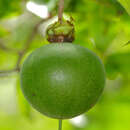Biology
provided by Arkive
Very little is known about this new species. The fruits of this tree are used in traditional medicine and the pulp may also be used by local people to make rattles (2).
Conservation
provided by Arkive
It is vital that any surviving trees are recorded and protected. There has been some success with growing trees from seed and the potential for reintroducing this species to the wild needs to be explored (2).
Description
provided by Arkive
This tree is known as 'feewu a wu' by local people and has only recently been recognised as a new species; it is so new to science that it does not yet have a specific name (2). The spiny tree may grow to around 6 metres tall; it bears small leaves, which have serrated edges with around 15 'teeth' (2). The small white flowers have oval petals and numerous yellowish stamens, which form a dense mass measuring around 3 centimetres in diameter (2). Hard, rounded fruits are produced, which are marked by roughly 9 lines running from tip to tip (2).
Habitat
provided by Arkive
It is thought that this tree was previously found in montane forest at around 1,900 metres above sea level (2).
Range
provided by Arkive
Endemic to Mount Oku and the Ijim Ridge of Cameroon in West Africa, this species was thought to persist only in cultivation (2). A recent expedition however, uncovered a single wild tree in the Bali-Ngemba Forest (3). Other cultivated trees are known from a number of compounds belonging to traditional healers; there are thought to be around 10 isolated trees in total (2).
Status
provided by Arkive
Classified as Extinct in the Wild (EW -) under IUCN Red List criteria (2).
Threats
provided by Arkive
This tree has lost from the wild probably as a result of the clearance of forests for timber and for the development of agricultural land (2).
Description
provided by Flora of Zimbabwe
Trees or shrubs, spiny (in ours). Flowers large and showy, solitary and terminal or lateral on short shoots, bisexual. Sepals 3-4. Petals 5-10 or more, exceeding the sepals. Stamens numerous, free. Ovary 1-locular. Fruit indehiscent, smooth or slightly ridged with a hard shell, many-seeded. Seeds with a smooth horny testa.
- license
- cc-by-nc
- copyright
- Mark Hyde, Bart Wursten and Petra Ballings
- bibliographic citation
- Hyde, M.A., Wursten, B.T. and Ballings, P. (2002-2014). Oncoba Flora of Zimbabwe website. Accessed 28 August 2014 at http://www.zimbabweflora.co.zw/speciesdata/genus.php?genus_id=972
- author
- Mark Hyde
- author
- Bart Wursten
- author
- Petra Ballings
Oncoba
provided by wikipedia EN
Oncoba is a genus of plants in the family Salicaceae. It contains the following species:[2]
References
-
^ "Oncoba Forssk". ipni.org. International Plant Names Index. Retrieved 2018-10-13.
-
^ a b "Oncoba Forssk". Plants of the World Online. Royal Botanical Gardens Kew. Retrieved 2018-10-13.

- license
- cc-by-sa-3.0
- copyright
- Wikipedia authors and editors
Oncoba: Brief Summary
provided by wikipedia EN
Oncoba is a genus of plants in the family Salicaceae. It contains the following species:
Oncoba brachyanthera Oliv.
Oncoba breteleri Hul
Oncoba routledgei Sprague
Oncoba spinosa Forssk.
- license
- cc-by-sa-3.0
- copyright
- Wikipedia authors and editors

